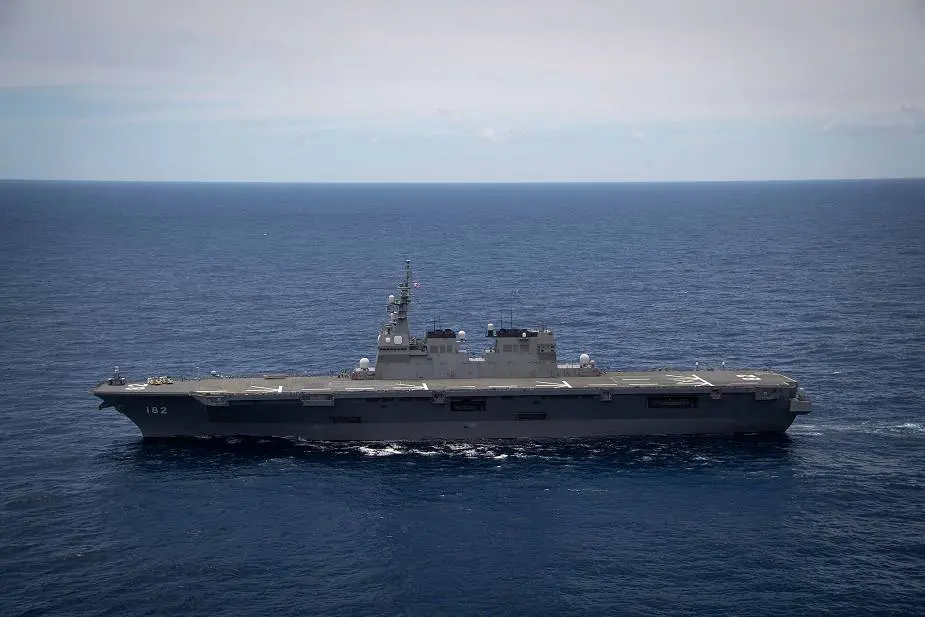Japan Maritime Self-Defense Force ship JS Ise (DDH 182) Hyūga-class helicopter destroyer is deployed near the coast of Hawaii during the Pacific (RIMPAC) exercise, the world's largest international maritime warfare exercise. RIMPAC is held biennially during June and July of even-numbered years from Honolulu, Hawaii.
Japan Maritime Self-Defense Force ship JS Ise (DDH 182) Hyūga-class helicopter destroyer is deployed near the coast of Hawaii during the Pacific (RIMPAC) exercise, the world's largest international maritime warfare exercise. RIMPAC is held biennially during June and July of even-numbered years from Honolulu, Hawaii.
Follow Navy Recognition on Google News at this link
 Japan Maritime Self-Defense Force ship JS Ise (DDH 182) steams in a multinational formation during a photo exercise off the coast of Hawaii during the Rim of the Pacific (RIMPAC) exercise. (Picture source U.S. Pacific Fleet)
Japan Maritime Self-Defense Force ship JS Ise (DDH 182) steams in a multinational formation during a photo exercise off the coast of Hawaii during the Rim of the Pacific (RIMPAC) exercise. (Picture source U.S. Pacific Fleet)
Ten nations, 22 ships, 1 submarine, and more than 5,300 personnel are participating in Exercise Rim of the Pacific from August 17 to 31 at sea around the Hawaiian Islands. RIMPAC is a biennial exercise designed to foster and sustain cooperative relationships, critical to ensuring the safety of sea lanes and security in support of a free and open Indo-Pacific region. The exercise is a unique training platform designed to enhance interoperability and strategic maritime partnerships. RIMPAC 2020 is the 27th exercise in the series that began in 1971.
JS Ise (DDH-182) is a Hyūga-class helicopter destroyer of the Japan Maritime Self-Defense Force (JMSDF). It is the second ship to be named Ise, the first being the Imperial Japanese Navy World War II-era battleship Ise. The Hyūgas are primarily anti-submarine warfare carriers operating SH-60K anti-submarine helicopters. They also have enhanced command-and-control capabilities to serve as flagships.
The Hyūga-class helicopter destroyer has a length of 197 m, 13,950t flat-deck vessel that can carry up to four helicopters on deck and operate 18 helicopters including SH-60K Seahawk anti-submarine helicopter and MCH-101 airborne mine countermeasure helicopter. The ship has a crew of 340 sailors and can only carry helicopters.
The Mitsubishi SH-60 series is a twin-turboshaft engine helicopter based on the Sikorsky S-70 helicopter family for use by the Japan Self-Defense Forces (JSDF). The SH-60K is an anti-submarine patrol version used by the Japan Maritime Self-Defense Force.
The AW101 is a medium-lift helicopter manufactured by the Italian company that was modified by Kawasaki Heavy Industries, and the Japan Defense Agency designated the model MCH-101. Special features include the automated folding of the rotor and tail. For the mine-hunting role, the MCH-101 has been outfitted with Northrop Grumman's AQS-24A airborne mine-hunting system and AN/AES-1 Airborne Laser Mine Detection System (ALMDS) for a complete surface-to-bottom mine detection capability, as well as Mk-104 acoustic minesweeping gear.
The Hyūga-class helicopter destroyer armament includes 16 cells Mk 41 VLS 'Vertical Launching System) able to fire RIM-162 Evolved SeaSparrow Missile used to protect ships from attacking missiles and aircraft, 12 RUM-139 VL ASROC anti-submarine missile, two 20 mm Phalanx CIWS (Close-In Weapon Systems), two triple 324 mm torpedo tubes and 12.7mm machine guns.







